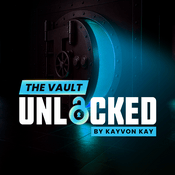13 episodes

Duck Tales: DuckDuckGo donations — why we’ve donated $8M+ to organizations that align with our vision (Episode 13)
12/17/2025 | 19 mins.
In this episode, Gabriel (Founder) and Joe (Policy team) discuss why we donate, the types of organizations we donate to, and some examples of impact. Disclaimers: (1) The audio, video (above), and transcript (below) are unedited and may contain minor inaccuracies or transcription errors. (2) This website is operated by Substack. This is their privacy policy.Show notes: See our full list of donations here. Gabriel: Hello everybody, welcome back to DuckTales. I am Gabriel, the founder of DuckDuckGo. Today I have with me Joe, and we’re gonna talk about donations, but you want to start introducing Joe.Joe: Thanks Gabriel. ⁓ So I am the senior public policy manager for DuckDuckGo. ⁓ What does that mean? ⁓ It sort of means that ⁓ I’m sort of the person in DC who sort of tilts at windmills, talks to Congress, works with lawmakers, and otherwise tries to keep the rest of the company abreast of how the US government and states are ⁓ pushing different types of regulations, solving online privacy. ⁓ and trying to make the internet a better place for everybody.Gabriel: Cool, yeah, and there’s probably a lot of good feature episodes in all that, which is the main part of your A small of your job is you took over really running the process in which we make our donations every year. I realize it’s a small part of your job, but it’s important one, and I think important to our users, so you want to explain just kind of what that is?Joe: Yeah, no, and look, I guess I shouldn’t oversell it, but I actually think it’s a really impactful part of the job. ⁓ It’s really, I think, like, it’s both, and we can talk about this, humbling and satisfying to be able to sort of allocate money to causes that are out there to try and improve trust online. ⁓ I’m our, I guess our DRI, our directly responsible individual for our corporate donations. ⁓ And this has actually become a pretty elaborate internal process to look at a whole bunch of different organizations. Now, I already mentioned I’m in DC, so I think about civil society groups, the Electronic Frontier Foundations of the world. ⁓ But we actually, you know, we give to a whole lot of different entities and organizations, ⁓ you know, sort of open source technology groups, ⁓ online technology reporters. and other organizations that do really impactful journalism on technology and data privacy. ⁓ And so, you know, I think there’s always sort of a push and pull to try and convince you to give us more money to give out each year. ⁓ But, you know, we give out, you know, over a million dollars to, I think this year it was something like 29 different organizations. ⁓ And it’s a, you know, it’s a detailed process. We spend a lot of months just arguing amongst ourselves about how we should allocate that money. And we’re, you know, we have a bunch of different criteria for what goes into this. ⁓ But, you know, we’re trying to both provide impactful donations. And so that means we give to a lot of small groups. ⁓ We’re also trying to sort of ensure that, you know, these groups are not just like aligned with us on one or two things, but are really out there trying to make the internet a better place. I mean, you know, if anybody’s been watching DuckTales, I think everybody would realize that DuckTales Go is a pretty mission driven company. And we’ve got this goal of expanding trust online. And we can’t do that ourselves. And there are a lot of different entities out there in the United States and globally ⁓ that are playing a really important role making the internet more trustworthy. And so we’re constantly trying to find ⁓ new voices to elevate and new projects to support.Gabriel: Yeah, as completely slightly a tangent, but you mentioned it because this is inside dark echo. At dark echo, we have this concept of the DRI directly responsible individual. What that means is someone who owns something and. We have, as you might imagine, tons of processes internally, one of them being this art under nation’s process and every one of them has an owner. Um, and so, yeah, that’s just a little insight in baseball for us, but hundreds of those and Joe owns this process and it often gets handed, you know, over time that changes ownership, but, um, that really means taking ownership of it and kind of, um, driving it forward and seeing it to completion. Um,Joe: Thank you.Gabriel: But yeah, donations, I also see it as extremely key to our vision. So we actually started doing this a long time ago. ⁓ I think I have the, for anyone who wants to look at everything we’ve donated to, we have a page, ducktogo.com slash donations.Joe: Good, it’s good that you got the microsite out there, that’s important.Gabriel: I just went to it. Yeah. Yeah.Joe: YeahGabriel: lists, it literally lists everything we’ve donated to, you know, including this year, 2020, all the way back to, guess, the first year we did this was 2011, which is a long time ago. What I was going to say is directly related to what you said is that was right around the time when we, 2011 was the first year we had our first employee. It was me just before that. know, Cade came on and when we did that, that’s when we started laying out our vision, like explicitly our mission and vision. Um, and we, the vision in particular, rates of standard of trust online hasn’t changed since, and it’s not going to change, but it was, it was kind of tied to that. We always said, you know, We’re one company. I think it’s really like what you said. We can only do so much on our own. We have a much broader vision. How can we push that forward? Well, we can donate to other places that could really help. Yeah, go ahead. Sorry. Yeah. Yeah, I think it was in service of, to another one of your points, of making a bigger impact.Joe: Okay.Gabriel: And so like my original thought was the dollar amounts at the very beginning were very small because we were very small and had no real revenues or profits. So there wasn’t ⁓ much to give, but we figured out, you know, we still put aside money to try to do so. ⁓ And so when we were doing that, and I think some of this is carried through to today, we were really trying to find organizations that could really do a lot with a small donation, you know, like, ⁓ and that might’ve been. project where an extra few thousand dollars could really help. And when it came to now, like maybe we give 25,000 or something and that enables somebody to ⁓ spin up a project or create a, someone part-time to on something. I think those are the kinds of things that can really make an impact. ⁓ I think the reason for doing the thematic ones early on is, you know, just concentrating the small amount of money we have into one thing and hoping to make an actual on that thing. ⁓ Now the dollar amounts are greater but we’re still picking themes it’s just probably three or four themes broadly in donations. I mean that’s the way I look at it. Yeah.Joe: Yeah, yeah. mean, I think now we pretty much are settled on, I would say, open technology or improving internet technology efforts, ⁓ data privacy. And then over the past few years, as we’ve been increasingly concerned about fair competition in digital markets, that’s become a bigger chuck. ⁓ But those are sort of the three buckets that think we’ve sort of narrowed in on, at least since I’ve been in charge of this.Gabriel: Yeah, and the process has evolved. Why don’t you take us through kind of the current bones of the process as it stands today.Joe: Yeah, that’s a good question. And I think actually a good opportunity to encourage folks to reach out if they want. you know, we like, there’s a couple of us internally that try to do a, some time over the year just sort of monitoring what groups are working on, ⁓ what they’re doing, whether it’s, ⁓ you know, basically sort of a subjective assessment of how impactful they are. ⁓ And then we have, I think it’s usually about a three month process that we kick off in you know, early summer to just sort of figure out like generally what are we interested in supporting over the year. And I think things that I think it’s worth highlighting that, you know, A, we’re a pretty community driven company. We’re also a team member driven company. I think it’s been really rewarding to have just ⁓ colleagues suggest, you know, organizations I had never heard of and that gets in there. So, you know, We are very much open to new ideas ⁓ and we support organizations globally, so I’m sure there’s plenty of things we have not heard of. So we create like a giant list of organizations and then we put it into a little bit of a rubric ⁓ and basically ask a number of questions about what we think the organization can do in the next year, ⁓ what actually would be impactful. Your point is totally valid. We’ve given money to support things like organizations being able to train up an employee. you know, think as you well know, like going from one to two employees can be hugely impactful for certain organizations. We’ve also, ⁓ you know, our support has allowed certain organizations to offer like health insurance to employees, which is not the, you know, really sort of makes you realize how, you know, some money can go a long way in things that are not just related to core, ⁓ you know, tech. projects, but literally people’s day-to-day well-being. ⁓ So we have this sort of rubric involved, and then we narrow it down. So part of the issue is we’d like to have a diverse, both geographic and ideologically diverse group of organizations. ⁓ We also sort of, at this point, have standardized our donation buckets a little bit. ⁓ we also like to keep a similar number of organizations. ⁓ You know, we started with, I think, six maybe, and we’re up to 29. And it becomes, and I think I’m one of these people, I’d love to give to every organization that exists, but that...Gabriel: And what are the buckets to you mentioned buckets like what kind of our bucketsJoe: yeah, yeah, that’s good question. ⁓ So ⁓ right now we sort of give organizations $25,000, $50,000, and then $100,000. Now there are some exceptions to that, but that tends to be where the donations fall. ⁓ yeah, ⁓ part of this is a lot of people are involved, and I should say it takes a village. It’s not just the policy team, it’s the communications team. that work on things here. obviously have to get involved at some point. ⁓ I think it’s really important and they deserve all the credit in the world and maybe a DuckTales episode for themselves. Our finance team has to do a lot of stuff here and that’s like the nitty gritty paperwork and taxes and stuff that ⁓ is not super, well, it might be fun for them but it’s not as glamorous as the laudatory press releases we get from some of these groups. ⁓ We have changed over years when we have given donations. ⁓ In the past, we’ve tied it to Data Privacy Day in January. We’ve tied it ⁓ to Giving Tuesday after US Thanksgiving. ⁓ This year, we gave out our donations much earlier ⁓ in September. And part of that’s just because I’d actually love to ask you, I know we’ve tried to get our community involved. And I know we’ve tried to make donations a moment in time. But it’s not the most attractive story in a world where we’re dealing with AI regulations and ⁓ competition breakups. ⁓ So it is always a question of when is the time to announce this in a way that could actually be impactful. And I think that’s an open question we’ve struggled with.Gabriel: Yeah, I’ve never cracked that code either. ⁓ So I open to your ideas there and it may be as the case. Yeah, we’ve had, we wanted to kind of like batch it so we can put it on the microsite and be like, here’s everything we did. And so I know we’ve given earlier in the year to some organizations who kind of needed it then, but then we tell that the announcement. but yeah, maybe there’s another way to do it where we kind of trickle it in over the year.Joe: Yeah.Gabriel: or something, know? I have no idea.Joe: I mean, if anybody out there has ideas and wants to reach out on Reddit or social media, I’m here to facilitate that. I mean, guess I should also say, ⁓ we’re always trying to ensure that Gabriel’s email isn’t flooded with requests and demand. So, I mean, one of the reasons I’m here today is, you know, if you’re an organization or an entity or your project that you think, you know, is in line with improving standards of trust online, ⁓ Please reach out. I’m happy to give you more information, happy to add you to our list of folks that we consider in 2026. ⁓ But I think part of my job as the policy person at DuckDuckGo is really to serve as a point of contact. And I’m here to answer anyone’s questions if you want to reach out.Gabriel: Yeah, well, people may take you up on that. To forward that further, I would say another thing that kind of distinguishes us initially, and this is in service of making an impact, and I’m pretty sure we still do this too, is we’re not really tying the donations to anything. A lot of philanthropic organizations say... ⁓ have to use it for this project, has to be earmarked for this, to your point, ⁓ supporting the organization for health insurance. I think that’s fine with us. We’re looking for impactful organizations where the money can really make a big difference. But if that’s the thing that’s going to make the organization more impactful, that’s okay with us because we’re more about the organization doing the job that it’s set out to do, mission. We have our mission. We’re supporting the mission of the other organization. And we want the organizations to exist. And often to exist, you need to give, in this example, your members health insurance.Joe: Yeah, no, absolutely. mean, I would say that our donations have never really had any strings attached as far as I’ve been running them. ⁓ It actually leads to some interesting back and forths with groups. And this is relevant because I just had a conversation with them. So this year, we are actually giving some money to Consumers International ⁓ as part of their effort to kickstart basically a year-long process to build ⁓ ethical and privacy principles around agentic AI and AI privacy. ⁓ And so, you know, they approached us and really wanted to know what our involvement would be. And they were like, this would be a good thing for you guys to get involved with. And we’re like, sure, you here, here, like run with it. You don’t you don’t need ROK to come up with privacy principles. ⁓ You know, we support privacy generally. And if you guys come up with something that we can adopt that. that would be great, like, you know, it’s not like you need us to rubber stamp what a global consumer group wants to do on AI privacy. So, you know, that’s been another interesting example. And it is also like something I certainly appreciate is a number of the groups over the year like reach out and they want to like check in and they have a whole lot of stuff going on. Some of it super relevant to, you know, DuckDuckGo’s interests, some of it pretty far removed. ⁓ And it’s, least from my perspective, it’s a really interesting opportunity to get exposure to stuff that ⁓ doesn’t fit into, I think, the four corners of DuckDuckGo’s policy priorities.Gabriel: Yeah, that’s interesting. yeah, you mentioned them. Are there any other organizations you think we should highlight maybe that we’ve given to a lot over the years? I mean, the one that jumps out to me is EFF. I know many years given to them, given the tour, many ⁓Joe: Yeah, ⁓ mean the tour project was there from the beginning as far as I can tellGabriel: Right, yeah, I think it was. So yeah, I think you, I don’t know how many, do you have a count of like how many organizations we’ve given to?Joe: Yeah, well, ⁓ and I put this into Duck AI earlier today, so if it’s wrong, it’s not my fault. ⁓ So we have given to a little under, I think, 100 organizations total over the past 15 years.Gabriel: Okay. so, yeah, so there’s been a lot of different organizations if we’re doing about 30 a year, but yeah, there’s been some that have been there a lot. so like, know Tor, EFF, Signal over the last few years comes to mind. I’m not sure if any other ones you want to highlight or just from this year even, maybe we haven’t given it several years, but you just want to name a few.Joe: Yeah, well, you know, I mean, I think one thing that I think is worth highlighting is we have increasingly given to organizations that focus on competition policy. ⁓ So in that respect, I want to give a shout out to Public Knowledge, which is a group that we’ve funded considerably. I mean, ⁓ this is a policy plug less than a donation plug, but, ⁓ you know, there aren’t a lot of tech-focused groups that think about competition. ⁓ And Public Knowledge is one of the exceptions to that. And from our perspective, there’s a huge host of problems with that. Like when you have lots of lots of big companies, they don’t have an incentive to protect privacy. so ⁓ supporting groups that sort of work at that intersection of competition and privacy ⁓ has been increasingly important to us.Gabriel: Cool. Yeah, this has been great. Anything else you want to highlight that we maybe didn’t cover?Joe: man I probably should have a better answer for that. ⁓ mean, again, I... No, no, no. mean, look, I think there’s... One of the things I have learned at DuckDuckGo is that there are always ways to improve processes and we’ve talked a little bit about our process. We are always trying to figure out ways to be more, I think, transparent with groups that are interested in funding and want to know, you know...Gabriel: Well the answer could be we did a great job and we’ve covered all the bases so that’s it.Joe: why we’re not funding them. ⁓ And so, again, I’ll just say that I think I exist to be a resource for that. So if you’re interested in funding, ⁓ please reach out. And I guess I’d say as we try and make this more of an established process, the earlier that folks can do that, the better.Gabriel: Yeah, okay, that’s a good point. Thank you for doing that, too. I never want to say no to people, so I always findJoe: YeahGabriel: an awkward discussion. But yeah, there’s only so much.Joe: ⁓ we’ve had some interesting conversations with groups this year.Gabriel: Yeah. But thanks, Joe, for coming on. Yeah, reach out to Joe, ⁓ if you’re an organization. Otherwise, check out our donations page at stucco.com slash donations. Everything’s listed there back to 2011. And ⁓ otherwise, hope you tune in for the next episode. you. This is a public episode. If you would like to discuss this with other subscribers or get access to bonus episodes, visit insideduckduckgo.substack.com

Duck Tales: Hiring at DuckDuckGo, and why we have a 95% employee retention rate (Episode 12)
12/10/2025 | 19 mins.
In this episode, Beah (SVP, Product) and Zbig (Director, Talent) discuss our approach to hiring, and how it’s designed to reflect our unique, cross-functional and mostly async ways of working. Show notes: Check out our careers page and open positions here. Disclaimers: (1) The audio, video (above), and transcript (below) are unedited and may contain minor inaccuracies or transcription errors. (2) This website is operated by Substack. This is their privacy policy.Beah: Hello. Hi, everyone. Welcome to DuckTales, ⁓ where we go behind the scenes at DuckDuckGo and discuss the stories, technology, and people that help build privacy tools for everyone. In each episode, you’ll hear from employees about our vision, our product updates, our approach to AI, or how we operate as a company, which is the zone that today’s episode will fall in. ⁓Zbig: Okay.Beah: introduce myself briefly. I’m Beah Burger-Lenahan. I lead the product team here at DuckDuckGo. And we have with me Zbig. Hey Zbig, do want to introduce yourself?Zbig: Yeah, of course. Hi, Beah. Hi, everybody. I’m Zbig. I’m on the Talent Acquisition team. I’ve been around for almost seven years now at DuckDuckGo, and I feel very privileged to have seen this amazing journey of us scaling the team from about 50 to over 350, where we are right now and I’m super excited to be here and talk about hiring.Beah: Awesome, thanks, the big. Yeah, so today we’re gonna talk about how we hire, what that process looks like, why, and so forth. Hopefully it’ll be interesting to everyone. ⁓ So maybe just to get started, can you kind of lay out at like the highest levels of our approach to hiring, what that process looks like?Zbig: course. Yeah. So I think at a, at a highest level, um, there is, you know, lot of intentionality and discipline to how we hire. So we would do that only when we have like a really clear and well articulated need. So when we’re scoping roles, right? Like we would want to deeply understand what the actual tangible problems are that we want that particular role to solve for us. And then we designed the hiring process to test for the skills, the competencies that are critical to being able to do that. So in practice, that means that we base that hiring process ⁓ largely on test projects ⁓ rather than interviews. Well, there are usually a couple of interviews in every process, but we definitely attach way more weight to test projects. We also tried to design that hiring process in way that ⁓ it’s truly like a two-way street and allows Canada to discover how we work. So, you know, they can make a well-informed decision at the end about whether or not this is good place for them. And I think one other thing worth highlighting ⁓ that comes out of this intentionality and discipline is the fact that, you know, never in the company history, we were forced to do any group layoffs. And when you look at the tech market these days, that’s very rare.Beah: Yeah, because we only hire people that we know we really need.Zbig: that will really advance the goals of the company, right?Beah: Yeah, got it. Okay, thanks. So let’s talk about the projects since they are, as you said, kind of the core of our process. Are these projects, do we expect people to do them for free?Zbig: Sure. Yeah. No, we offer payment, which is kind of like average bubbly, but it’s usually like anything from 50 to 100 US dollars per an estimated hour of work required to complete a project. These are, and this is just like recognize the time candidates put into those. These projects are always role specific and designed to simulate the actual work one would be doing on the job. You can complete them async on your own time. And I truly believe that allows candidates to demonstrate the best of their abilities without the typical pressure and stress of interviews. And also like when you think of the async format, that much more closely reflects how we work on a daily basis at DuckDuck. Because I think that probably like, I don’t know, 70, 80 % of collaboration here happens asynchronously. There are a few meetings throughout the week. And ⁓ we’ve picked this format for the hiring process very intentionally. There’s actual research behind that that proves that work samples, test projects that are role specific, they’re much less prone to bias and error than interviews. And what we found through that ⁓ is that they are great predictors of future success on the job. And when you look at our retention rate, that’s 95%. You know, our engagement scores are also very high, like I think 86 % way above market benchmarks for companies of our size and at our stage of growth. like there’s actual, you know, quantitative validation that this approach works very well for us.Beah: Yeah, is it challenging to get people to commit to doing these projects? It can be a bit of time.Zbig: It is one of the bigger challenges of our hiring process because these test projects can take anything from like three, four hours up to 15 and in some cases maybe 20. And we typically expect folks to complete two of those, two sometimes three. So that’s like a time investment of about 25, 30 hours in test projects. I think we do our best to really to adjust to Canada’s availability. There’s like from our side, there’s no pressure on like when exactly they should be starting on those. They can plan ahead, set that time aside. If they need an extension, they can just let us know. And we usually have no problem to grant that because we understand that different things can come up in life that could derail their plans. So So we really try to adjust our pacing to candidates, be very flexible with those timeframes to ⁓ make it feasible for them.Beah: Got it. I’m shifting gears a little bit. So where do we hire in the world and why?Zbig: Hmm. So we hire globally though, not everywhere. We have like a selection of countries where that we’ve decided scale to based on like ⁓ a pretty nuanced estimate on the available town pools, how those relate to our needs, ⁓ how easy it is also to like scale within them from the administrative financial logistics perspective, perspectives, but we are able to hire across tens of countries around the the globe. And I think that’s awesome because that gives us access to amazing talent ⁓ that often when you think of some of these countries, there aren’t that many opportunities to work on something of a comparable scale that Go offers. So we’re way more competitive there, right? And we’re truly... I’m actually in Krakow in Poland and we have a pretty pretty big contingent here, like I think one of the fourth, fifth biggest representations geographically across the company with over 20 people. yeah, there’s definitely a great advantage of this remote setup that enables that. ⁓ And I think also what makes it possible is the fact that as a company, we’re designed from ground up for full remote collaboration, right? When you think of the companies that were switching to remote during the pandemic, that often didn’t work out and many of them are now calling people to go back to the office because they didn’t really have the right processes and culture to enable effective collaboration. I think that’s definitely not the case here.Beah: Where are you located today?Zbig:Beah: Yeah. Yeah. I will say, mean, the remote ⁓ employee base has challenges for sure, and it has a lot of upsides as well. I think for me, like one kind of just fun perk of it is that it’s cool to know people from all over the world. ⁓Zbig: yeah, for sure.Beah: you know, when I think about like traveling I think, ooh, like who can I go see?Zbig: Yeah. And also when you think of like, we’re building a global product or a set of global products, right? And I think it’s invaluable to have people from different geographies representing different cultures and perspective, because that helps us inform like how we can be building those products for a broader audience that really ⁓ meets their needs and solves jobs for them.Beah: Yeah, makes sense. So you mentioned ⁓ one of the challenges of our hiring process is getting people to commit the time to the projects. Are there any other significant challenges?Zbig: Mm. Yeah. I think the probably the biggest one is related to how we work. Cause as you know, we’re pretty uniquely organized over here. There’s no middle management. There’s no like separate project management function. And in practice, that means that everybody really is expected to be able to scope, propose and execute projects. Sometimes that means, you know, managing a cross-functional project team and that skillset is not that easy to get on top of the functional expertise, Like functional competencies. So ⁓ we often end up hiring, you know, we do most of our hiring in engineering and at a senior individual contributor level, like senior engineer, and we often end up hiring folks, you know, performing these like more senior leadership related responsibilities elsewhere, sometimes even like holding more senior titles than what, we have on the job description. Disclaimer though, don’t use job titles internally. We don’t want them to get out of picking the best solution or going in the most optimal route. We try not to make decisions based on authority. And that’s worked well for us, I think, over the years.Beah: . . I’m curious. I’ve never asked you this question or I don’t know the answer. Do candidates find it appealing that we don’t use titles internally or does it put some people off?Zbig: Thank I think many of them, I think many of them do, and they do highlight, well, we get a lot of that feedback from candidates in the hiring process, but some of them do raise it as an objection. And I get it. you know, I think typically on the market, there’s a lot of weight attached to job titles, right? Because they demonstrate certain progression throughout one’s career. And some candidates decide not to give that up, which I totally get, right? Like if someone is already like, I don’t know, staff. engineer, principal engineer, and the max they can get here with us is a senior level position. ⁓ I understand why, you know, a certain percentage of people would not want to do that, right? But in practice, though, like for people who really care primarily about the ability to make impact in the org, that title here, it doesn’t... doesn’t matter really, right? Like it does not give you more authority or impact in any way.Beah: Yeah. So I think like in our conversation so far, a lot of it has been about this like very particular point of view that DuckDuckGo has that ⁓ may be different from a lot of companies, a lot of hiring processes.Zbig: Mm-hmm.Beah: ⁓ But my sense is also that we have evolved, like while we have a very particular point of view, it is not a stringent one that has been the same for years and years and years, like it’s evolved quite a bit. Any significant changes in your time here that you think are worth calling out?Zbig: yeah, yeah, of course. And I think at a higher level even like we continue to iterate and improve all of our processes, right? ⁓ And that applies to hiring as well. So like one of the big things we had in the past was the so-called internal contracting period when, you know, once you completed the hiring process, we didn’t bring you in full time, but we asked you to do some sort of a part-time internal contract. you know, do some you know, a single sometimes maybe two projects as part of the team, but not working with us full time. So usually people, I did that too. It wasn’t the best experience. So the first thing I did after joining was to look at the data of like, okay, how many people going through that actually join, right? Like how big of a filter is that in our hiring process? And what it turned out was that, well, we actually bring in everybody. Like there was, think one exception that that we weren’t even like sure about going into that internal contracting period. But the data told the story that, well, the hiring process itself is such a good predictor already. We don’t need that. And that was a, I think that was a great change because it enabled us to engage with people who otherwise would not be able to invest that time on top of their jobs or personal obligations, right? So that was definitely a big enabler in accelerating the pace of hiring.Beah: I did that. ⁓ back. Got it. So we did that, that was like inspired by you not having a good experience, like the con, you being kind of put off by the.Zbig: Not just me, There was a broader, like my experience was one of the data points, but there was a broader discussion with leadership where, you know, we looked at like, okay, how scalable is that? Like we’re hiring maybe 20, 30 people per year. We were when I was joining, but we were looking at increasing that substantially, right? So it wasn’t a great experience for candidates. wasn’t a great experience for people internally. Ask to oversee those internal. contracting period, so there were multiple arguments for making that change. But only when we examined the data, we knew that, OK, that’s up. It doesn’t make sense to be doing that anymore.Beah: Mm. Yeah, that makes sense. You mentioned we were hiring maybe 20, 30 people a year at that point. Can you talk about what our hiring volume looks like now?Zbig: Yeah, so it’s our record year this year. So I’m super pumped about that. We are on 80 hires this year, ⁓ which is absolutely amazing. Yeah, yeah, there may be a couple more. So we’ll see. ⁓ But yeah, it’s really great to see that growth. And we’re bringing in some amazing people. So yeah, that’s super cool.Beah: And we got 2 months left to go. Yeah, do you think we, over the process of the last few years, our ability to make the right selection in terms of both people that will be successful here and that will be happy and thrive and want to stick around has improved?Zbig: I think so, yeah, and quite considerably. ⁓ So we were looking to tighten the feedback loop for new hires to get an even better sense of how fast new hires are reaching full productivity. But when we look at the data, ⁓ the success rate is very high. And ⁓ we rarely have instances of new hires failing to meet expectations, which is another benefit of this highly disciplined, intentional approach. ⁓Beah: Yeah, you mentioned 95 % retention. Yeah, that seems very good.Zbig: retention. Yeah, that’s continued over the years, right? Like when we scaled from 50 to over 350, we’ve managed to maintain that. And I think we’re only getting better.Beah: Yeah, I remember when I was in a much loosey-gooseier process to be hired at DuckDuckGo seven-ish years ago. was talking to Gabriel and I was kind of asking him about what it’s like to work at DuckDuckGo and he was like, mean, nobody’s really left in the last four years. It wasn’t exactly what he said, but was something like that. Basically nobody had left in years, maybe like one or two people. ⁓Zbig: Right. Later. Yeah, yeah,Beah: Okay, one more question for you and then ask if you have anything else you want to say before we close. what, I’m curious what proportion, where are coming from? ⁓ What portion of hires are referrals versus inbound?Zbig: So the vast majority comes through inbound, and that’s a combination of our Curious website and ads we post on LinkedIn and other job boards. But Curious is still, I think, the main contributor there. It’s, I think, 64 % for inbound total. And that makes sense, right? We have such a big user base where pretty popular among engineers. A lot of our hires are actual users of our products, which is amazing because then they contribute with their feedback and thoughts to helping us improve our products. ⁓ Similar to other companies, ⁓ the second best source of hires is referrals. I think a quarter of our hires ⁓ come from referrals and ⁓ that’s always been a great source also in terms of the retention and performance of these folks. So we’re trying ⁓ to leverage that as much as possible.Beah: Also, just interject that when we hire people who are not users of our product. They’re also really great at helping make the product better because my question is, why aren’t you a user? What’s stopping you? I mean, we expect everybody to use our products once they’re here, but it’s sort of nice to have people who maybe like weren’t dedicated, loyal users ahead of time because they maybe have a different basis of comparison and also reflect a large number of users that we would like to ⁓ list.Zbig: For sure. Of course. Yeah. I think. Exactly. I think it’s great to have both of these perspectives, right? ⁓ Because the non-users, they usually bring a completely new set of eyes and views on our product offering. So yeah, I think we’re really contributing from having people from both of these poles.Beah: Yeah, what anything else that you want to share before we wrap, Sabing?Zbig: I think, yeah, I mean, like one other interesting thing is that it does take a lot of effort to hire, you know, and we have multiple people from our functional teams, engineering, other teams too, involved in the hiring process to help with test project reviews, to help with interviews. And perhaps for this, I looked up the data and, you know, only this year we’ve done over 2300 project reviews and 790 almost 800 interviews. So yeah, it’s a huge effort that goes into that. But we honestly think it’s worth it. Like getting hiring right and making sure that people who bring in will make a positive impact that will be happy here. I strongly believe this is one of the most powerful levers we can be pulling as a company. I think that effort is totally worth it. And of course, we continue to look at how we can optimize and improve the efficiency of the hiring process so it’s less of an effort. But that’s a continuous process,Beah: . Okay. Yeah. Awesome. Well, thank you, Zabig. That’s all I got.Zbig: Awesome. Well, super happy to be here and thank you for this. That’s been great.Beah: Alright, see you later!Zbig: See ya. This is a public episode. If you would like to discuss this with other subscribers or get access to bonus episodes, visit insideduckduckgo.substack.com

Duck Tales: How DuckDuckGo makes the sites you visit less annoying and more private (Episode 11)
12/03/2025 | 14 mins.
In this episode, Beah (Product) and Max (Frontend) discuss cookie pop-up protection, why our solution is uniquely private, and the feedback loops we use to help us reject cookies across more of the sites you visit. Disclaimers: (1) The audio, video (above), and transcript (below) are unedited and may contain minor inaccuracies or transcription errors. (2) This website is operated by Substack. This is their privacy policy.Beah: Hello and welcome to DuckTales where we go behind the scenes with DuckDuckGo and discuss the stories, technology and people that help build privacy tools for everyone. In each episode, you’ll hear from employees ⁓ about our vision, product updates and our approach to AI or how we operate as a company. In this case, today we’re going to be talking about a feature that I dearly love.⁓ cookie pop-up protection with ⁓ Max here. So let me just do some quick introductions, I guess, before I’m kind of getting a little ahead of myself. I’m Bea Berger-Lenahan. I lead the product team here at Tech Tech Go. And I’m going to be asking Max a few questions. Max, would you like to introduce yourself?Max: Yeah, sure. Hey, ⁓ my name is Max. I am an engineer in the front-end team at DuckDuckGo. Been here for about three years, a little more. Yeah, I’m excited to talk about cookie pop-up protection.Beah: Awesome. Thank you, Max. We’re glad you’re here. I’m glad you’re here. ⁓ So first, just tell me, tell all of us a little bit about what cookie pop-up protection is, how it works.Max: Yeah, so this is the ⁓ feature in our browsers that handles cookie pop-up for you. ⁓ And in a nutshell, it... ⁓ that’s a good question. ⁓ I mean, I think most people have seen a cookie pop-up, but yeah, the definitions vary, but we’re talking about these...Beah: What’s a cookie pop-up first? HahahaMax: dialogues that websites show you on the first visit that typically tell you something about their data sharing practices and the use of cookies and similar technologies. And sometimes they give you a way to opt out of some optional tracking ⁓ or cookies. And that’s what we’re actually doing. We’re automating, ⁓ basically clicking reject buttons for you or whatever it takes to...toggle all these little checkboxes and saving the settings. ⁓ I could demo it if that’s okay. ⁓ So let me share my screen. ⁓Beah: That’d be great.Max: So for the sake of the demo, I’ve disabled the feature in the settings right now. It’s enabled by default, ⁓ but I’m just going to show you. ⁓ So if we go to Sky Scanner, for example, and I’m in the Netherlands, so you see a Dutch version, but there is this huge cookie pop-up ⁓ when you load the page. And if I enable the feature, cookie pop-up protection and reload the page, you’re not gonna see this pop up anymore. And what happened, and then there will be a ⁓ little notification in the address bar. And if you drill down, you’ll see the explanationBeah: Okay. Okay.Max: what happened. But basically what happened behind the scenes is we clicked on the reject button rejecting the cookies automatically. And that’s why we call it cookie pop-up protection. ⁓ So for us, this is a privacy protection feature because it actually ⁓ chooses the most private option for you, which is not always easy. Let’s see.Beah: Mm-hmm. Yeah, I mean, I don’t know if we have data on this, but I imagine very few people are willing to go into, you know, click the option to actually adjust ⁓ settings and start toggling things on and off on the regular.Max: Yeah, ⁓ that’s for sure. So ⁓ some pop-ups can be really tricky to opt out. ⁓ You would need to go to click, Settings and then toggle a bunch of check boxes and then click Save. This can become... Like most people, think they just click Accept button. ⁓ And ⁓ yeah, this is of course not good for your privacy. ⁓ So we help...Beah: Yeah.Max: getting through these dark patterns.Beah: Yeah, makes sense. why did we build this? What’s the origin story?Max: Yeah, so ⁓ like many other features that go, it started as like a hack project, which is when someone goes in and tries to tackle the problem in a couple of days. And ⁓ of course, cookie pop-ups are universally annoying and wanted to do something about it. ⁓ And we built some prototypes. And then eventually we built a feature on top of a ⁓ prior work of my colleague, Sam Macbeth, who... ⁓ So we have an open source library that does most of the ⁓ things that we... ⁓ And we ⁓ use it and it powers all our... ⁓ This feature in all our browsers.Beah: Nice. ⁓ Max, did I cut off your demo? Did you want to show anything else there?Max: No, I’m trying to stop presenting it just doesn’t work. I’m clicking the buttonBeah: Oh, okay. Alright, I was just worried I cut you off. Alright, we’ll see if it responds at some point. So, okay, so just to recap, ooh, there it goes, okay. Just to recap, we are a, removing the annoyance of you’re like trying to go to Skyscanner, I don’t know what that is, you’re trying to go to Skyscanner and instead of getting whatever it is that’s on Skyscanner, you’re getting this big like notification in your face, we’re making that go away and we’re going in and we’re changing the settings to be more privacy respecting. That sounds great. What’s the downside?Max: Correct. And that’s, so like ⁓ this ⁓ approach actually is actually quite intentional, right? So as I mentioned this, we’re trying to maximize user privacy and ⁓ because there are other solutions on the market that do like ranging from clicking accept button, which is not acceptable for us. But also ⁓ there’s another approach of like preventing the interaction. And for us, this was very important to do it this way, to actually actively opt out because, well, first of all, ⁓ this is like the only way to opt out of ⁓ server side tracking we know of. ⁓ the second, it gives a clear signal to the website through the official channels.Max: And then finally, in some legislations, it’s actually the only way to opt out. So for example, in California, they can sell your data by default unless you click on the button. So ⁓ yeah, we think that as long as the site is compliant with the law, this approach is better for privacy. ⁓ And if it’s not compliant, we still have our tracker blocking and other privacy protections to fall back to. And so this is of course, so speaking of challenges, ⁓ this is a bit more involved than just, you know, blocking some requests to or blocking the pop-ups from loading. ⁓And so it needs a bit more effort because we actually need to automate each and every pop-up vendor. So it takes a bit more effort. But yeah, this is something we chose to do. I think we, for a while now, we’ve covered most of the, all of the major pop-up vendors, which is like 80, 90 % of top sites in Europe and the US.Beah: So that’s roughly the percent of cookie pop-ups that we think we’re successfully blocking at this point.Max: Yes, so that is 80 or 90 % of all pop-ups that you see on the top sites are handled. And one of the biggest challenges is this long tail of sites, because of course, no one visits just the top sites. And like, each of us has this one site that no one else visits.Beah: Mm-hmm. Okay.Max: And yeah, this is something we’ve been focusing on lately. We’re trying to ⁓ experiment in with automated approaches and using AI as well. And we’ve had some good success in the past months with it. So I think we’re gonna ramp up the this long tail coverage in the coming weeks and months. Yeah, andBeah: And how are you finding those? Do you want to talk about like how your finding those sites, which includes internal reporting, right?Max: Yeah, so we have a few different ⁓ feedback loops, as I say. of course, we have ⁓ our own crawling. So we ⁓ regularly crawl top sites ⁓ and trying to detect new pop-ups and handle them. ⁓ Then we have user reports, ⁓ breakage reports, and just user feedback reports. that we have special systems that filter out and surface the reports related to cookie pop-ups. And we also have very active internal reporting, which is DuckDuckGo employees who go above and beyond and just report new sites to us. is a very important source of feedback because we can get back to those people and verify.Beah: Who’s the number one reporter of cookie pop us.Max: the number one is Gabe. ⁓ So our CEO, he’s like, I think it’s fair to say that half of all the internal reports come from him. I have no idea how he does it.Beah: Hahaha I know. Yeah, sometimes I think maybe I can catch him, but I don’t know. I don’t know that I can. ⁓ So if a user watching this encounters a cookie pop-up, what should they do? How should they report it?Max: Yeah.⁓ So it depends on what kind of user there are. Like the easiest thing would be to send the feedback through the app. We have this ⁓ feature. Or if something actually doesn’t work, then feel free to send the breakage report, site breakage report at this. But if you’re actually a developer, thenThis whole thing is open source. And we welcome external contributions. You can go to GitHub, ⁓ find this library, called AutoConsent, and file some issues or even pull requests. This is always welcome. And we’ve had some external contributions before ⁓ from also other companies who are using this library. It’s not only ⁓ used in DuckDuckGo apps. ⁓ So yeah, if you’re that person, we’ll be happy to.Beah: Nice. So to recap, have to be, you only get this feature if you’re using our browser. If you’re using search and you click in another browser and you click on a search result and you land on a page with a cookie pop-up, we can’t really do anything to help you there, much as we’d love to. So you got to install our browser. But if you are using our browser on mobile or desktop, you can go into the menu and there’s a send feedback button and That’s a good way, like we actually read those, so please do send that feedback and we will try to fix it.Max: Yes, that’s right. So make sure to mention clearly that this is about cookie pop-up not being handled or some issue with cookie pop-ups and then we will see it.Beah: You can say, dear Max, please fix this cookie pop-up. But you have to be polite, obviously. Awesome. All right, before we wrap, Max, is there anything else that you want to add that we haven’t touched on?Max: Yeah That’s a possibility. ⁓ No, really just I’m excited ⁓ to spread awareness of this feature because ⁓ you know when it works and it does work you don’t notice it so anything we can do to ⁓ let people know that this exists and that it actually ⁓ helps.Beah: Yeah, here, here, the time when I notice it is when I go into other browsers to test things or experiment with something and I get all these cookie pop-ups. And I’m in the US, so I’m sure it’s worse if you’re in Europe, ⁓ and I’m just like, how do you live with this? So, and I scurry back to our browser. Awesome, well, thank you so much, Max. It’s been great learning a little bit more about cookie pop-up protection. Appreciate your time.Max: Yeah, thank you for having me. This is a public episode. If you would like to discuss this with other subscribers or get access to bonus episodes, visit insideduckduckgo.substack.com

Duck Tales: The DuckDuckGo Subscription — more protection & peace of mind (Episode 10)
11/26/2025 | 25 mins.
In this episode, Gabriel (Founder) and Chris (Subscription team) discuss why we built the DuckDuckGo Subscription, its four features, and how it protects more of what you do online. Disclaimers: (1) The audio, video (above), and transcript (below) are unedited and may contain minor inaccuracies or transcription errors. (2) This website is operated by Substack. This is their privacy policy.Show notes: Learn more about the DuckDuckGo Subscription here. Gabriel: Hello everybody. Welcome back to DuckTales, everything DuckTale go. I’m Gabriel, founder, CEO. I got with me Chris. Do want to introduce yourself?Chris: Yeah, hi, I’m Chris Calvi, ⁓ long time listener, first time caller. Had to say that. ⁓ But ⁓ I’ve been at DuckDuckGo for a little over four years. I’m on the partnerships team here. And ⁓ I guess I’ll take a second to talk about the partnerships team, what we are. ⁓ We are primarily the team that handles all of the relationships with third party companies that DuckDuckGo works with.Chris: We’re a relatively small team, about 10 people. you know, classic examples of companies that we’d be working with are any of the live information that you’re seeing when you search DuckDuckGo. So that would be like sports scores or stock quotes, weather, that sort of information, also like flights and lyrics, all of those relationships, we get that information, we license it from...from other companies. that would be an example of work we would be doing. And then also, we will even work on things like infrastructure partnerships with cloud partners and AI companies and all that stuff. So that’s what we do over here at Partnerships more recently.Gabriel: Interestingly though, the way we work, and this gets more inside deck to go since the name of our blog on this, we don’t really work functionally though. We have objectives inside the company to get a particular thing done, and that thing usually involves many different functional teams. What that also means is those objectives have owners and they can be from any functional team. ⁓You tell me how you think of that, but I think if you do what doing recently actually was not very partnershipy. You’ve been helping launch different parts of our Dr. Go subscription, which involves some partnerships, but like your day-to-day job is not always partnership related.Chris: Yeah, mean, absolutely. And I think you as people, if they listen to a bunch of these episodes, they’ll see that. People might be leading an objective and they’re on the design team or in this case, the partnership team. A lot of times it is somebody from the product team. And in this case, I’m working a little closer on the product side. So you’re right.Gabriel: And yeah, so we’re going to talk today a little bit more deeply because you’ve been working on it about the DuckDuckGo subscription. We’ve mentioned it on some of these episodes, but haven’t really given a big overview. So that’s what this is going to be. The subscription is a bundle. So it’s got a bunch of different things in it, which maybe you can get an overview in a second. But just to say that we might have separate episodes about going deep into some⁓ One of those things are a technical aspect to them, but this is we can give more of an overview of kind of where it came from and what it exists today and kind of where we’re headed with it. You want to start and just tell us kind of like what’s in it and how it works.Chris: Yeah. Yeah, that sounds good. The DuckDuckGo subscription is a relatively new thing for us. We launched this in April of 2024, so it’s really only been around for a year and a half compared to the search product, for instance, that’s been around for a very long time. And what it does is really, I mean, in a nutshell, it supercharges some of the existing functionality you have. It gives you extra privacy features within your DuckDuckGo ⁓ app and experience. ⁓ It does a little beyond that too, which we’ll talk about, but that’s the key thing. ⁓ The other thing I will note is that if for long time subscribers, you may have originally remembered it being called Privacy Pro. That was the original name for it. We recently just changed it to DuckDuckGo subscription for to keep things simple. So we’ll call it the subscription for the rest of the episode. ⁓ But before I like...Gabriel: Yeah, give us the basics. yeah, what’s in it? Yeah.Chris: Yeah, the basic things, the four basic things in there are the, you got the VPN, which we’ll talk about what that is in a second. You get access to advanced AI models within Duck AI. You ⁓ get personal information removal, which I’ll talk about what that is, as well as identity theft restoration. But before I go down all that, I did want to ask back to you about ⁓ why we came up with a subscription. and then I’ll kind of unpack each of those core pieces.Gabriel: Yeah. Yeah, I mean, the way I think about it more broadly is we want to be your clean internet experience. Like if you want a more protected way to operate online where you’re not getting followed by ads and you’re not giving up your personal information, you kind of adopt the DuckDuckGo ecosystem. And so that’s our browser, it’s our search engine, it’s our AI product. And generally we want to offer those essentially for free. mean, there’s advertising model in the search engine that pays for this, but we can, we want to give it for free in the sense that mo because more people can use it around the world. However, there are certain protections that costs us a lot of money to do that we hadn’t been able to offer because of that. So VPN is the obvious, a canonical example there, because when you turn on the VPN, now all your bandwidth is running through that VPN and a lot of that’s video. ⁓ And it’s just not something that can be advertising supported. doesn’t, the numbers don’t add up. And so we’ve wanted to offer that because it is a key part of being fully protected for people who want that kind of fuller protection, but we couldn’t offer it for free. And so we needed a subscription. At that point, I thought, hey, we could just offer a VPN, but...I think there are other things in this category that have real marginal cost in business terms. ⁓ And it would be great if we could bundle them all together at one low price and allow DuckDuckGo users who really want more protection ⁓ to be able to get it in one place. You don’t have to sign up for multiple things. And that’s where the subscription came from. ⁓ I think we’re living up to that. hope over time we add more and more things and make it more and more valuable without increasing the price or much at all. ⁓ But yeah, that’s where it came from.Chris: Yeah, I mean, that makes sense to me. to dive into the four pieces of functionality, I’ll start with VPN, because you mentioned that. We probably should give a little bit of a high level of what a VPN is. So it stands for virtual private network. But what that means is that we basically have this anonymous private secure no logs VPN server that’s sitting out there, right? And we have these in 40 locations around the world. You likely are connecting to the one closest to you, but you can change it to go to another country. But what it does is all of your internet traffic, the requests that you’re making to, for instance, as you browse the web, are gonna be securely essentially tunneled through that server and then sent out to the resource where you’re requesting that information. So the website that you’re accessing,they’re not going to see, under normal conditions, without a VPN, they would see your IP address. In this case, they’re going to see the DuckDuckGo server’s IP address, which is meaningless, essentially, to them from a privacy perspective. So it preserves your privacy on that front. then they’re sending that information back, and then it’s coming back to you. So then the second place where it’s adding privacy is on your own, sort of like your internet connection. So if you’re...⁓ you’re making that request in a lot of cases your internet provider or if you’re using like a public Wi-Fi, they can see the sites that you are accessing and sometimes can see the information that’s coming back and forth. And in this case where it’s that since it’s all being encrypted and coming through the duck, going to DuckDuckGo server first, they’re only seeing that you’re connecting to this one server and that they’re not seeing any of the data in between. So it gives you sort of that two different protections when you use a VPN. I don’t know if I’ve done it justice.Chris: Yeah, I think you did a great job there. The only thing I would add to that is, yeah, so it really shields your IP address and other information from leaking to both your internet provider and the sites that you’re visiting, as well as all the places in between too. People may not realize like when you route across the internet, you connect to something and then you connect to like a bunch of different hops in between lots of other internet providers. And it shields not only from the end points, but everything in between.⁓ Additionally, the IP address is often used to get your location. ⁓ And so by effectively shielding your IP address, you’re effectively shielding your location. And the final thing I would add is like, it may seem esoteric, like do I need to shield this stuff from these people? ⁓ But it’s been well documented that ISPs, internet providers are selling this data all the time. ⁓ And so...If you want to be maxing protected, you do want to have the VPN. ⁓ And you know, I leave it on all the time, our VPN. The other thing, the final thing I would add, which you know, doesn’t relate to the privacy necessarily, but it kind of relates to it in the sense that trusting us is that we decided not to sub license this VPN or anything from anybody else. We are operate, we made this from scratch. We’re operating all the servers ourselves. ⁓ And so it’s fully DuckDuckGo operated.Chris: Yep. ⁓ Thank you. ⁓ And then on the kind of jumped into the next feature that I had mentioned was the advanced ⁓ AI model. So you get in Duck AI. So ⁓ Duck AI is free. You don’t need an account to access it. And it’s our AI chat ⁓ product. But if you’re a DuckDuckGo subscriber, you get ⁓ access to advanced models and higher limits on the models that are available for free.So the advanced models sort of the difference between the advanced models and the free models Well the advanced models just to name them are ⁓ open AI’s GPT 4o GPT 5 Anthropics ⁓ Claude sonnet 4 and Metas llama for Maverick and So we have these are available if you’re a subscriber and then we have the free models which are available to everyoneThose free models are great for lighter weight tasks that are optimized for speed, whereas these more advanced models are made for more complicated prompts and more challenging scenarios. I don’t know if you have anything to add on to that.Gabriel: No, that’s a good explanation. The only thing I would add would be it’s for the same reason like the VPN, like these advanced models cost a lot of money to run. when you’re the computation on advanced models, it’s more computation, more computation, it’s more cost. And so we just couldn’t offer them for free. But as part of the subscription, it’s a natural fit. if you’re paying for it, and we haven’t said the price yet, so why don’t you explain what our pricing is?Chris: Yeah. So.Gabriel: But if you’re paying for it, we can afford to give you this. But we’re still trying to strike a balance here and give. We’re not trying to make tons of money off this. We’re trying to give a good price for the bundle. And so we think we’ve been pricing it competitively.Chris: Yeah, absolutely. I should, yeah, let’s step back. the thing I’ll say is it’s available in 30 countries today. So the U S Canada, UK, and all 27 member countries of the European union. And you, the price in the U S is nine 99 a month and it’s nine or 99 99 a year. So basically $10 a month or a hundred dollars a year if you sign up annually.⁓ And then it’s that’s basically in your local currency if you’re subscribing from one of those other countries ⁓ But you can get a free seven-day trial too. So ⁓ That’s that’s important to note so you can give it a spin See if you like it and then if you do like it you can continue onGabriel: Got it, okay, so we have VPN and DuckAI advanced models. Now as I understand that those are available in all those countries, the other two features are more US, or there’s one of them US specific and one of them we need to talk about how it might differ, right?Chris: Yeah, yeah, let’s talk about personal information removal first because I think ⁓ that one is US only. And the reason for that is, you could probably go on about this, it’s primarily a US only problem. And so the way that, what happens if you’ve ever searched, for people listening, have you ever searched the internet for their name, which I’m sure everyone’s done at some point you’re going to see yourself show up in, especially if you type in your name in your city, if you have a less common name, you’re going to see a bunch of stuff show up, lot of of spammy sites that have your address, maybe your phone number, email, some other information, maybe socials. This stuff, ⁓ they are selling essentially, and in the US, a lot of countries make that illegal, in the US it’s not. So ⁓ what we will do is with personal information removal is,We help you go out and on your behalf, we opt you out from I think at least 80 sites like that today and we add more all the time. And so that’s how that works. Yeah, but I don’t know what else you have to add onto that.Gabriel: No, you’re right. I mean, that’s why it’s in the US because it’s just not a problem. It’s not really a problem outside of the US. I mean, the only thing I would add would be this is one of the reasons why people are getting tons of spam, texts and junk mail previously, now lots of, you know, everyone’s got a phone, spam, texts. And so if you remove yourself from these sites, that will reduce as well as potential for identity theft. And spam emails too, sometimes the emails out there. ⁓ In any case, ⁓ it’s US only, but if you’re in the US, it is a real problem. And I suggest you do something about it, if not from us, from somewhere, because it really does make a difference if you remove the things. Now, the other thing I would say, and we’ll probably do another episode of this, is that these sites are often, like you said,they’re buying and selling information from other sites and other places. And so if you just remove yourself once, your information will come back on these sites eventually because they ⁓ just buy it again and get it from somewhere else or from public record or something like that. That’s another problem with the US is they get it off from public records. like you like buy a house or something and they end up buying that information. ⁓ But that’s why you want a service to do it because we are constantly, the service is monitoring it and scanning these sites repeatedly. And so if your information shows up again, three months later, it’ll get noticed and then we’ll submit another removal request to remove it. So it’s kind of like always working in the background to remove yourself in an automated fashion from all these sites that we cover.Chris: Is it worth talking about kind of how that information stays on your local machine in this?Gabriel: Yeah, I think so. I think so because it’s a differentiator and it took us a lot more time to build this because of that. But I do think it’s a privacy benefit and worth it relative to other sites that do similar. Yeah, you want to explain it? I can do it too if you want.Chris: Yeah, mean, well, when you said it’s happening in the background, what we mean is quite literally on your computer in the background. It’s not happening on your data, you know, because we need, in order to opt out, you need to provide your name, right? And some information so that the service can opt you out. So rather than that information living on our servers and then doing the opt outs, it lives on your computer and does the opt out.And to your point, you mentioned that’s a differentiator. And it’s like a core thing for us is that we don’t want your personal information. As much as possible, we just don’t want it. And so that’s, I think, was worth mentioning with this product.Gabriel: Yeah, I’m actually not familiar with any other product that does it that way, that where your information really doesn’t live on an account on the server. It’s on your, in this case, your browser. It’s built into the browser. I think there’s two reasons for that. One is to do that, you have to have a browser. So we have a browser. So we were kind of uniquely able to do this versus like a web service. And also it’s a really pain to build this, to actually get it to work in the background. I don’t think anyone would do this. unless they really wanted to get that privacy protection ⁓ maximum, which is what we generally do. ⁓ So yeah, it’s unique in that regard. ⁓ We should probably mention that that is desktop only for that reason, because it was very difficult to bring it to mobile. But we’ve been working on bringing it to mobile. And that’s kind of like next step for personal information removal is bringing it to our iOS and Android browser.Chris: Yeah, I mean, I’m glad you mentioned that because I know that that is a big piece of feedback we receive. A lot of our users use, they may only use us on mobile, they may only have a mobile device, and so they’re not able to currently use this functionality unless they get a desktop going and get it going on there. So it’s exciting news. ⁓If we pivot over to that last piece, the four, so there’s the VPN, advanced AI models, personal information removal, and then that last one is identity theft restoration. This is essentially in the instances where you are the victim of ⁓ identity theft. ⁓and you mentioned that it’s a little bit the function, that way that it works is slightly different whether you’re in the US or in another country. If you’re in the US, if you use identity theft restoration, they’ll be able to do ⁓ some of the, if you’re trying to restore your credit and everything like that, whatever was stolen, they’re gonna give you guidance on how you can, ⁓ you’ll connect with an advisor, essentially you’ll make a phone call.They’re going to help you, they’re going to handle your case, help you get your identity restored. In some cases in the US, they’ll actually be able to handle some of that work on your behalf. They may be able to contact financial institutions and things like that for you. ⁓ For identity theft restoration outside of the United States, they’re only going to be able to provide you the steps, essentially. The guide, like they’re going to say, this is what you have to do, then you’ll have to do it. So that’s one, that is a different it’s worth noting between the US version and the ⁓ version available to everyone else. ⁓Gabriel: Yes, and so like this, I mean the way I think about this is, you know, we’re really trying as a company with the product to cover all the bases for you, you know, online and protection in your life. And so we’re, you if you use our product, you’re really reducing your personal information out there, essentially to the maximum you can easily. But it can never go to zero, unfortunately. And if someone’s really trying to target you,Maybe they’re looking through your garbage, who knows? You ⁓ can be a victim of identity theft and there’s a lot of people who have been the victim of identity theft, unfortunately, it’s not a small problem, certainly in the US. I know more about the US, but ⁓ it’s a big problem in the US in part because we were talking about those laws earlier. ⁓ But if you are, it can really be a big pain. ⁓Gabriel: People can open bank accounts on your behalf and credit cards and spend money. They can mess up your credit report. And so what this is is essentially a peace of mind such that if that happens, we’ve partnered with this service that 100 % focuses on helping people restore their identity. So you will get a personal advisor to really walk you through this process so you’re not on your own. And they do it every day.you that’s their whole business is what they do is help people restore their identity. ⁓ And so by buying into subscription, you’re essentially buying the, ⁓ for this part of the subscription, the ability to have access to this advisor should you unfortunately find yourself in this situation, which we hope never happens. But if it did happen, you’d have this ability to help you.Chris: Great, yeah. That covers the kind of the four, I don’t know how we’re doing on time, but that covers our four pieces of function.Gabriel: We have no real time limit. This is longer than we’ve normally gone, but we have, this is a big topic, so we don’t have to go super much longer, but if there’s a few things or anything else you want to hit, we could do so.Christopher: I I guess, like, I’ll just kind of piggyback. You made that point earlier about the subscription is about providing the extra functionality that would normally, that costs money, essentially. The other stuff we’re able to do in an ad-supported way or in a free way, whereas this, you know, the things that we’re offering here, it doesn’t work. You need to pay for it, essentially. ⁓ what I will say is that it’s very complimentary.to everything that DuckDuckGo is doing on the free side. And we continue to grow and add new stuff on the free side ⁓ all the time. But what I’ll say is that if you are a current user of either our search or ⁓ DuckAI or our apps, this is, like I’ve found it to be ⁓ just incredibly complimentary. It sits very nicely on top of all of that. You turn it on.⁓ And to your point, you said you use the VPN all the time. I use it all day, every day. I’m using it right now on this call and I use it ⁓ on my phone all day. ⁓ And it’s really quite delightful to have that extra protection on top of everything else and to have the extra AI models, know, GPT-5. 5 Mini is in the free version, but 5, just 5 is not. And so you get that with the...with the subscription and so, yeah, think I’ll just end it there. Some of the stuff that I really like about the VPN is you can opt out, know, unlike for instance the Mac version, you can exclude certain sites because certain sites don’t play as well with a VPN, like ⁓ some streaming video for instance, like Netflix, you might run into issues where they’re not gonna stream it to you. So you can exclude a site or, ⁓in my Android app I can snooze, ⁓ which you can snooze the VPN for 30 minutes, which is really great for if you’re troubleshooting or if you can’t access your bank’s app or whatever through. So that happens from time to time.Gabriel: Yeah, these are good points. mean, yeah, we can wrap it up. I mean, I agree it fits nicely and is designed to fit nicely just on top of our regular stuff. And in particular, it’s built in, it’s mainly built into our browser, right? So if you get it, then you have some extra stuff going on inside your experience that you can get access to. I should also add that a lot of the things that you just mentioned, those are new features since we launched this description. So.We’re adding new free stuff all the time. We’re adding actually stuff to the subscription all the time. You know, we have, we’ve plugged a few times, but we have a quarterly update website, ducktico.com slash updates. I think it’s slash updates. Yeah, okay. And you can go through and look at like quarter by quarter, there’s a section for the subscription and you can see, you know, what we’ve been doing there, but like we’re constantly thinking about what to add to it. So it’s not going to be static. In fact,Chris: It is, yeah.Gabriel: the AI model aspect of it, you worked on, just got added recently, right? So we have more coming and ⁓ yeah, so thanks Chris, thanks for coming on. Thanks everybody for listening this long. ⁓ I think we’ll do deep dives. I think we should do deep dives on each of the four things in a future episode. I think those would make good episodes. Yeah, cause there’s so much to cover there. All right, let’s get out of here. Thanks everybody.Chris: Yeah, for sure. For sure. All right, thanks Gabriel. This is a public episode. If you would like to discuss this with other subscribers or get access to bonus episodes, visit insideduckduckgo.substack.com

Duck Tales: Marketing at DuckDuckGo — how we practice the privacy we preach (Episode 9)
11/19/2025 | 9 mins.
In this episode, Cristina (SVP, Marketing) and Chuck (Front‑end) discuss private marketing at DuckDuckGo, from making decisions with less data to the role of privacy engineers in marketing projects.Disclaimers: (1) The audio, video (above), and transcript (below) are unedited and may contain minor inaccuracies or transcription errors. (2) This website is operated by Substack. This is their privacy policy.Cristina: Hi, and welcome to DuckTales, where we go behind the scenes at DuckDuckGo and discuss the stories, technology, and people that help build privacy tools for everyone. In each episode, you’ll hear from employees about our vision, product updates, engineering approach to AI, or how we operate as a company. Today, we’re going to chat about how most companies collect a ton of information through their marketing activities and how DuckDuckGo, given our privacy policy of we don’t track you, do things like attribution very differently.I’m Cristina, I’m on the marketing team, and today I’ll be interviewing Chuck. Chuck, you wear a lot of different hats. Can you introduce yourself and some of what you work on?Chuck: Sure. ⁓ I am technically on the front end team and work on the front end of our search projects, our products, and our subscription products. ⁓ But I ultimately do whatever I need to do to get the job done, which is kind of our DuckDuckGo ethos. I do some product management, some data science, back end engineering. I work with the marketers. It’s fun. ⁓ And I need access. So getting to where lots of them is.Cristina: Hahaha. Fair enough. Well, thank you. So much like our product philosophy, privacy is core to the ethos of our marketing. There are so many common practices we don’t do, identifying and targeting individual users, retargeting, using behavioral data, using third party cookies and pixels, the list goes on. And we’ve also declined working with a lot of vendors because they don’t meet our privacy standards. As a consumer, that’s something I really appreciate.But frankly, as a marketer, it makes the job very hard. But it’s getting a bit easier thanks to work from people like Chuck, which is why I was so excited to talk to you today. So Chuck, when you first started working with the marketing team, what was your reaction to our limitations and what we were hoping to achieve?Chuck: Honestly, I was a little shocked. ⁓ There’s a pretty well-understood playbook for how marketing in a space like this should look. A playbook of tactics and tools that are well-understood. And every company will do it differently, and every brand and product will have their own personality. But we pretty much use none of those tools.Cristina: Yeah, can you help people understand what the industry norms are for marketing attribution and data and how we do it differently?Chuck: So when you visit your favorite social media site and it’s trying to decide how to fill the ad slot in your feed, the ad platform will take what it knows about you as a person, your search history, who you follow, and what it knows about your situation, like where you are and who you’re with, and line it up with their ad inventory. They’ll do some very complex math to determine the perfect ad to show you that will maximize profits for the platform and the advertiser. So the more better data they have about you, the better they can target the ads and the more money they can make.I know that’s something you’ve talked about with Peter on a previous episode, that the financial incentive for the trackers that are ubiquitous online is data that feeds the machine that helps them make more money off of your ad space. That entire ecosystem just flies in the face of our privacy principles. In fact, some of our apps will block those trackers to keep your browsing private. So when we advertise, we refuse to use those tools like you just listed that are common in digital marketing, like retargeting or reporting different types of conversions after the ad click. ⁓ just to protect the privacy of our users. Instead, we’ll collect limited data only when there’s a very clear and urgent rationale for it. And when we do, we’re transparent about what we collect and how we use it. And we’re possibly most important. We’re really careful never to let those logs link two different events to the same person. That’s really difficult to do. ⁓ We have a really fantastic privacy engineering team that reviews every project and their implementation to make sure that the work we’re doing is aligning with our principles.I’ve also gotten really comfortable making decisions with just the imperfect or incomplete data, trying to identify the solutions that meet 80 % of the business needs without, with 20 % of like the potential input.Cristina: Yeah, it feels like a lot less than 20 % of what’s actually available to us. Well, yeah. So thank you for unpacking that. That’s a helpful foundation. Can you go a bit deeper and talk about what that looks like in practice at DuckDuckGo?Chuck: Yeah. That’s probably fair.Yeah, so we largely ⁓ don’t work with other vendors ⁓ in the marketing space and rely on the tools we own and build ourselves instead. That makes sure that we aren’t incidentally feeding the machine with our own users’ data, which is really easy to do if you’re not careful. ⁓ We have a couple of tools in our toolbox, too. We’ll do as much summarization and analysis of data locally before we ever send it back. So rather than saying that a user of our browser searches15 times in a day and ⁓ sending 15 different events for those searches, we’ll send a periodic report that will say they searched 15 times during that day. We’ll reduce the precision of those signals even further. So instead of saying that that person made 15 searches, we’ll say they’re a medium volume search user. And then when we do our analysis on an ad campaign, we’ll look at the summaries of the data rather than the raw data ⁓ so that we’re looking across our users rather than the individual humans.And if it comes down to it, we are willing to redact data that might be too identifying for a person, whether it might contain PII or if it looks too unique and may be able to be traceable back to a person, we’d rather delete it and not use it than jeopardize that person’s privacy.Cristina: Well, thank you for ⁓ sharing how our ethos really comes to life there. And I’d love for you to touch on one of your claims to fame at DuckDuckGo, which is creating a better, more privacy-respecting system that we call Origin. Can you talk about how you got the idea and how you brought it to life?Chuck: Yeah, so we were struggling to run small scale campaigns that test new ad platforms or creatives. ⁓ With the tools that we have, the only way that we could do that without jeopardizing user privacy is to run big, broad, expensive, scaled campaigns. But we’re a small company. We want to move nimbly. And that made it really difficult for us to quickly validate our direction and make sure that we were dedicating our resources in the right time or in the right place. So I spent some time with our marketing leaders, including you, Cristina. ⁓trying to understand the norms and the challenges they were facing, the tools that weren’t in their toolbox. And I brought that to the privacy team. ⁓ We worked backwards, starting with user privacy as a first principle to the business goals and landed on a solution that kind of looks like this. ⁓ You see an ad and you click on it for DuckDuckGo and you install our app from it. When that app first runs, we will send one signal that says that you installed the app from that ad in that location.And then once a day, we’ll build a summary of those signals that give us pretty coarse insights that say, you know, we had 10 users install our app from that ad on that ad platform on that day. Then we’ll line that data up with other information that the ad platform gives us, like how many impressions there were of the ad and how many times it was clicked and how much that cost us. And that’ll give us some high level insights we can use to start making decisions, like how much it costs us to ⁓ per install from that ad. There’s nothing groundbreaking here technologically.It’s actually intentionally very simple and that helps us maintain the privacy properties because we have a high elevation view of everything that’s happening. We never share data outside of DuckDuckGo, so we aren’t feeding that machine. There are never person level insights. We’re looking at broad signals across our audiences. There’s no risk of PII and we’re only collecting the data that we need to make those decisions, nothing more. But it still lets our marketing team make informed decisions while working quickly and doing their jobs well.Cristina: Well, thank you. ⁓ More importantly, thank you for the months and months of work you did on that. ⁓ You say it’s nothing revolutionary, but actually, I think it’s a pretty novel approach. We don’t know of any other companies using technology like this. Typically, they use the entire suite of tools available to them. ⁓ But hopefully, one day, it won’t feel like such a novel approach, and this will become more of the industry standard. At least my naive perspective can hope for that.Chuck: Of course. I hope so. We’ll see if capitalism agrees with this.Cristina: So any parting thoughts you’d like to leave on the future of privacy respecting marketing?Chuck: One of the things that I really love about and appreciate about DuckDuckGo is the example that we set for other companies. ⁓ On the search engine side, could we collect data at massive scale and hyper-target ads to our users? Absolutely, but we don’t need to. And we love being an example of a sustainable business that respects user privacy in their searches. And I like to overlay that to our marketing efforts too. Would we benefit by using really invasive tracking like the industry standards? Yeah, probably, but we don’t need to.We’re a good example of how you don’t need to participate in that data intensive ecosystem to market your business. And I’m really proud to work on it.Cristina: Well, thank you, Chuck. I feel the same way. And for those of you listening, if you or someone you know considers themselves to be a privacy-centric marketer, including ad networks and measurement partners, would love to chat, reach out to me on LinkedIn with what you’re doing differently. Chuck, it was really great chatting with you today.Chuck: Always check, great to chat with you too.Cristina: Thanks to everyone who took the time to listen. We have so many more episodes planned on a wide variety of topics, so stay tuned. Bye. This is a public episode. If you would like to discuss this with other subscribers or get access to bonus episodes, visit insideduckduckgo.substack.com
More Business podcasts
Trending Business podcasts
About Inside DuckDuckGo
Listen to Inside DuckDuckGo, Habits and Hustle and many other podcasts from around the world with the radio.net app

Get the free radio.net app
- Stations and podcasts to bookmark
- Stream via Wi-Fi or Bluetooth
- Supports Carplay & Android Auto
- Many other app features
Get the free radio.net app
- Stations and podcasts to bookmark
- Stream via Wi-Fi or Bluetooth
- Supports Carplay & Android Auto
- Many other app features


Inside DuckDuckGo
download the app,
start listening.







































